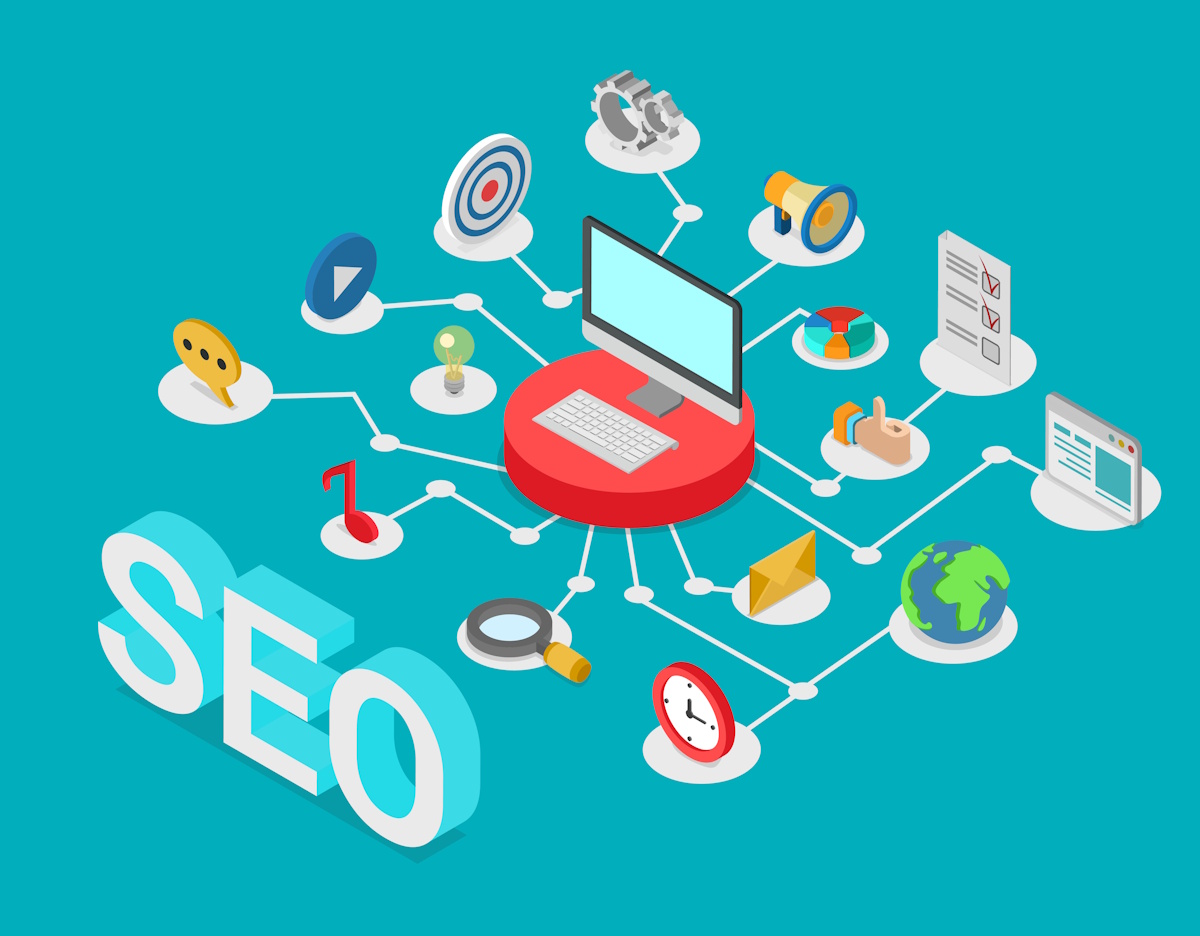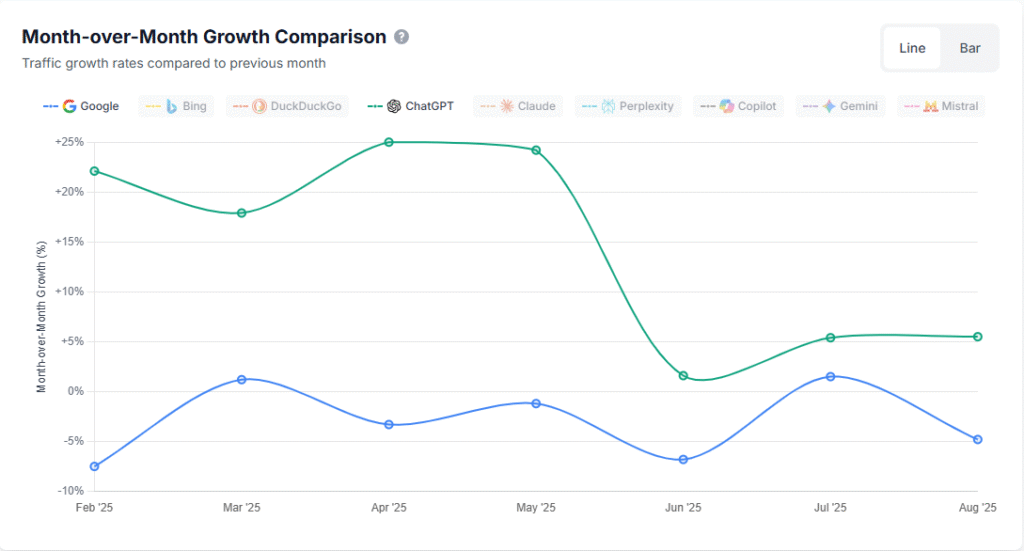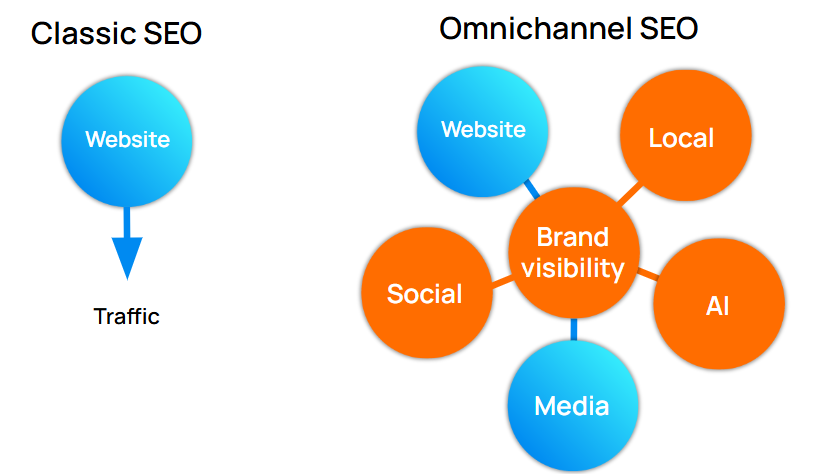
SEO keeps evolving and so should your strategy. Today, brand visibility lives across many touchpoints: Google Search and Maps, YouTube results, Google News and Discover, social platforms that appear in SERPs, and AI answers from LLMs (AI Overviews, AI Mode, ChatGPT, Gemini, Copilot). If your brand is missing from these places, you’re missing opportunities.
An omnichannel SEO strategy doesn’t replace classic SEO, it expands it. Instead of focusing only on your site’s rankings, you need to align multiple channels so they reinforce each other. Your news content feeds into Discover. Your reviews boost your Maps presence and reinforce trust. Your videos get indexed in search. And your service and blog pages show up in AI Overviews.
Who benefits most?
- Companies that rely on inbound leads and want steadier, compounding growth
- Local and multi-location businesses that need map visibility and reviews
- E-commerce and SaaS brands competing in crowded categories
- Publishers and media teams that need reach across Search, Discover, News
- Any brand that wants to reduce ad dependency and build durable organic reach and AI visibility
What is an omnichannel SEO strategy?
An omnichannel SEO strategy is a unified plan that connects website SEO, social content that ranks, local signals, and GEO (Generative Engine Optimization) for LLMs. It treats every touchpoint as part of one system: shared topics, consistent structure, clean technical foundations, and clear brand signals.
At SEONIQ, this is what it looks like:
- Your brand voice is consistent, whether on Google, YouTube, or ChatGPT.
- Your website is optimized and is the hub that connects all other signals.
- Content is structured so humans enjoy it and LLMs can use it.
- Trust factors (reviews, mentions, citations) push authority higher.
- You don’t depend on ads, because your organic presence works everywhere.
Why Omnichannel SEO matters right now
Search is no longer a straight line. Users don’t just type a keyword into Google and click the first link. They watch a YouTube video, scroll TikTok for quick takes, check Maps for directions, or ask ChatGPT for a recommendation. Google itself is pushing AI Overviews and AI Mode, changing how results are displayed and cutting down on clicks.
According to SEMrush (2025), AI Overviews already appear in over 13% of Google searches and when they do, click-through rates drop dramatically. That means fewer visits for brands that rely only on traditional SEO.
Another analysis from Ahrefs confirms that Google still dominates as the primary traffic source across industries. However, ChatGPT has shown a much faster growth rate (see chart below), proving that user behavior is shifting and AI tools are gaining ground.

If your brand isn’t visible across multiple touchpoints (search, local, social, and AI) you risk being invisible where your audience actually makes decisions. That’s why omnichannel SEO is no longer a “nice-to-have.”
Benefits of an omnichannel SEO strategy
So, why go omnichannel? Because users are everywhere and attention is fragmented. If you’re only optimizing your website, you’re ignoring half the journey your audience takes. With an omnichannel strategy, your brand earns compounding visibility that stretches across search engines, maps, social platforms, and AI tools.
Here’s what you gain:
- Multiple entry points for discovery: your audience can meet you on Google, TikTok, Maps, or inside AI answers.
- Higher-quality traffic: you attract people searching with real intent, not random browsers.
- Brand visibility and recognition: consistent exposure builds authority and makes your brand easier to cite in SERPs and AI outputs.
- Lower ad reliance: organic growth means you’re not dependent on a paid campaign to stay visible.
- Future-proof growth: when Google shifts algorithms or introduces new features, you’re already optimized to show up.
Classic SEO vs. Omnichannel SEO
Traditional SEO still matters,but it’s only part of the picture. Optimizing just your site is like speaking in a room when half your audience is outside. Omnichannel SEO makes sure your voice carries further.

Classic SEO focuses on your website: fixing technical issues, optimizing content, building backlinks. That’s still critical, but users don’t only live on websites anymore. Omnichannel SEO adds new layers: discoverability on social platforms, local relevance in Maps, visibility in AI Overviews or ChatGPT, and presence in news ecosystems like Google Discover.
In short:
- Classic SEO = Website-only, traffic-focused.
- Omnichannel SEO = Website + social + local + AI + media, all working together.
Common mistakes brands make
Many businesses still treat SEO as if it’s 2015. They focus only on their website, buy a few backlinks, maybe run some ads, and then wonder why results are flat. Here are the most common mistakes we see:
- Relying solely on ads
- Ignoring local and social
- Chasing rankings, not relevance
- One-size-fits-all strategies
Forgetting about AI (LLMs like ChatGPT, Gemini, and Copilot are shaping how users consume information. If your content isn’t optimized for them, you’re out of the conversation.
These gaps are exactly where omnichannel SEO fills the void.
How to build an omnichannel SEO strategy
Here’s the secret: omnichannel SEO isn’t a single project. It’s a continuous process where you need to adapt to algorithms, platforms, and user behavior. A good omnichannel SEO plan starts with your goals and evolves as algorithms, platforms, and user behavior shift.
Here’s how what you need to succeed:
- Define your goals and brand voice. Visibility is pointless without direction. Start with what matters most to your business.
- Plan your content architecture: blogs, landing pages, videos, and FAQs aligned with your audience’s intent.
- Website SEO optimization: technical health, Core Web Vitals, crawlability, structured data, and strong on-page foundations.
- Social SEO:. optimizing posts, videos, captions, and titles so they surface in Google, YouTube, TikTok.
- Local SEO. Maps, reviews, Google Business Profile, and local directories that make you the first choice nearby.
- GEO (Generative Engine Optimization). It means structuring your content so LLMs like ChatGPT, Gemini, and Copilot can understand and cite it.
- Backlinks & digital PR. Build authority with credible mentions, media coverage, and natural link growth.
- Entity building & citations: strengthening how search engines and AI recognize your brand.
- Spot opportunities: track new SERP features, trending queries, and AI developments.
- Monitor & adapt: continuous tracking of traffic, rankings, and AI presence, with ongoing optimizations.
How SEONIQ does omnichannel SEO
Plenty of agencies talk about SEO. At SEONIQ, we live it. And we know the rules of the game are changing fast. That’s why we don’t stop at classic SEO.
What we do:
- We design every plan around your brand’s goals, audience, and industry specifics.
- We optimize your entire digital presence: search engines, Maps, social platforms, AI-driven answers.
- Structured, human-friendly, and LLM-friendly content that gets discovered, read, and cited.
- We don’t disappear after an audit. We adapt, monitor, and evolve your strategy month after month.
Experience meets innovation : 10+ years in SEO and content marketing, blended with a forward-looking approach to AI search and omnichannel integration.
Ready to see where your brand stands? Get your free 30-minute SEO consultation.
Photo credit: Freepik
